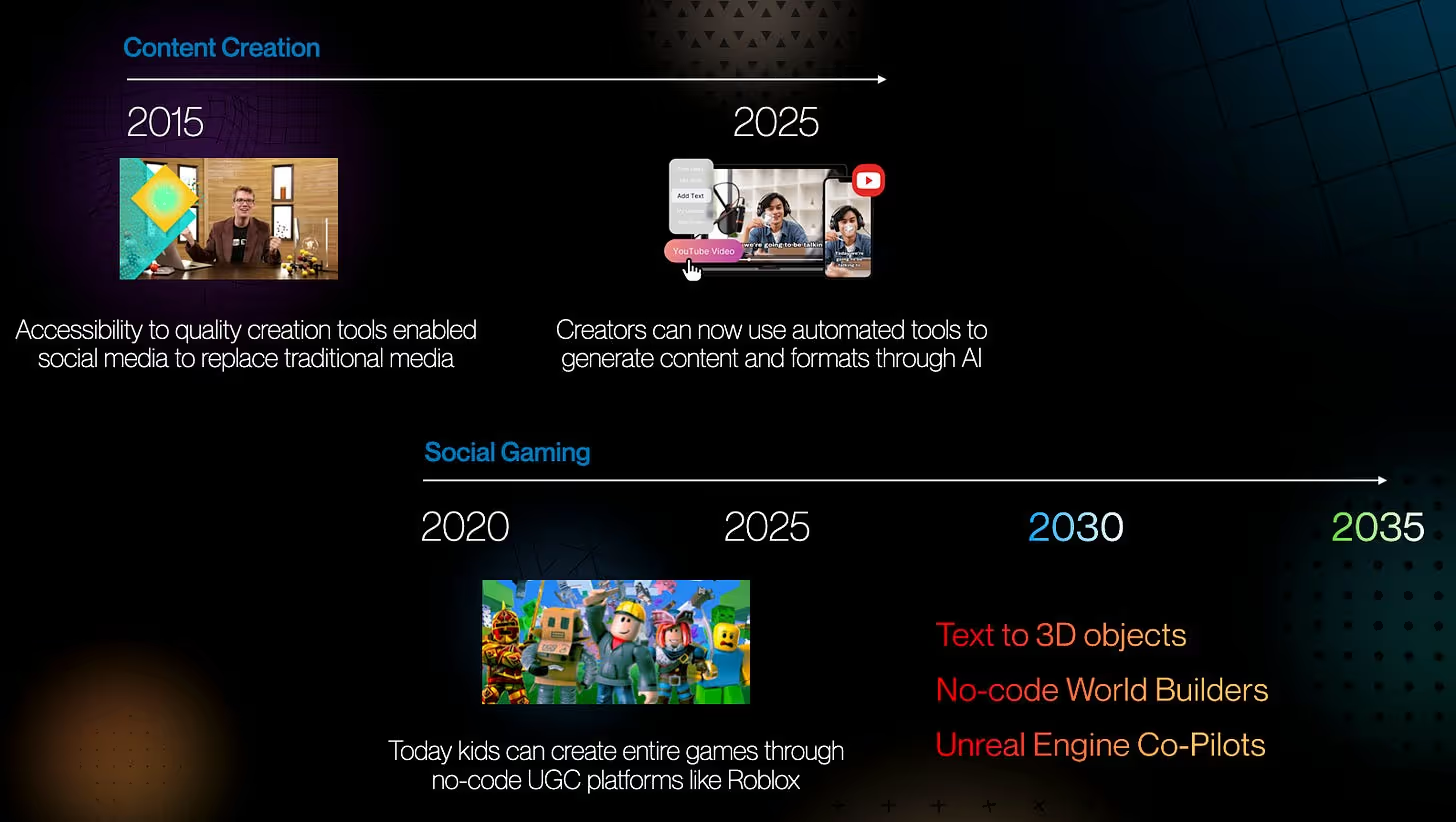In every major technological revolution, a hidden shift redefines how we live, connect, and play. Artificial Intelligence is no different. While most investors chase productivity tools, LLMs, and humanoid robots, the real transformation is quietly unfolding at the fringes—within gaming platforms, immersive environments, and creator ecosystems.
As AI increasingly takes over our work, one critical question emerges: Where will humans spend their time—and their newfound wealth?
Productivity and Leisure
The consensus trade is clear: AI will rival the productivity boom of the industrial revolution or the internet. It will make businesses more efficient, reduce friction, and replace rote tasks with machine learning. The global economy will benefit.
Projected AI productivity gains by country:

But the best opportunities don’t sit in the consensus trade — they emerge in the knock-on effects.
As productivity increases, human labor becomes less essential. As automation handles our needs, we’re left with more time, more money, and a deeper desire for entertainment, challenge, and self-expression.
That surplus doesn’t just disappear. It flows somewhere.
Historically, it flows into leisure. Since the 1920’s the average household has more than doubled their expenditures in this category, now making up nearly half the average household income.

Over the past 30 years, this has increasingly meant excess wealth flowing into gaming.
Since 1990, gaming industry revenue is up over 800%.
In 2024, it crossed $347 billion globally.
Over 3.3 billion people now play games — over 40% of the world’s population.
Gaming is no longer a side industry — it’s the digital commons.
And in the AI era, that commons is transforming again.
The Rise of the AI Creator Stack
Gaming’s evolution mirrors that of traditional media.
In the beginning, studios dictated the experience. Players took what they were given—passively consuming content built for everyone, yet tailored to no one.
Then came user-generated content (UGC)—starting with mods, maps, and skins, and eventually evolving into entire player-built worlds.
Today, platforms like Roblox and Fortnite Creative are enabling entire generations to build worlds from scratch — and thanks to AI, they don’t even need to code.
AI-native tooling is unlocking a new kind of creator:
- Text-to-3D generation (scenario: “build me a fantasy village”)
- No-code world builders (drag-and-drop game logic with generative props)
- LLM copilots in Unreal Engine
- Automated NPC dialogue powered by GPT-like models
- Instant level design, soundtracks, even economy balancing
In short: what YouTube did for video, AI is now doing for interactive experiences.

And when you combine frictionless creation with an audience of billions, you get the most powerful economic force in the modern web: network effects.
UGC is Eating the Gaming World
For Generation Alpha, UGC isn’t a feature — it is the game.
They’re not just players — they’re creators, curators, and influencers. Roblox isn’t a product, it’s a platform for self-expression. Fortnite isn’t just a shooter, it’s a social hub.
We’re watching the same transformation that social media underwent 15 years ago:
- Traditional Media → Social Media
- Traditional Gaming → Social Gaming
And just like social media, the dominant platforms won’t evolve out of the games that have the best graphics or the biggest studios — they’ll be the ones that empower creativity at scale.
Social Gaming Is the New Social Media
Social platforms in the 2010s were feed-based: photos, captions, likes.
In the 2020s and beyond, social platforms are spatial and participatory.
Gaming is becoming the new public square.
It’s where kids hang out after school.
It’s where identities are formed, challenges are tackled, and friendships are made.
Roblox is the third place for hundreds of millions of players.
VRChat is the new dive bar.
Gorilla Tag is the new playground.
We’re already living in the Metaverse — we just don’t call it that anymore.
Where We’re Placing Our Bets
At Hartmann Capital, we’ve broken the opportunity down into four buckets:
- Platforms – Environments where people gather, play, and build. (i.e. Squido Studio)
- Tooling – AI-native creation engines, asset generators, multiplayer infrastructure. (i.e. Ludus AI)
- Social Infrastructure – Digital identity, creator tools, communications infrastructure. (i.e. LIV)
- Talent – Studios, brands, and creators crossing worlds and platforms. (i.e. DressX)
The Future Will Be Spatial
We believe that in an increasingly AI-driven world, the cost of goods and services will trend relentlessly downward, shifting the core of human consumption toward the richness of our experiences. Entertainment will evolve from passive consumption into active creation—experiences that challenge us, deepen our connections with others, and push us to explore the boundaries of our imagination.
AI is the catalyst turning every player into a creator, the accelerant making immersive worlds easier, faster, and cheaper to build, and the intelligence layer transforming generic digital experiences into deeply personal realities. Gaming platforms, empowered by AI, will become the new hubs of social interaction, collaboration, and creativity. Players won't just consume—they'll shape entirely new realities.
The future will be spatial, and spatial will be social.
Disclaimers:
This is not an offering. This is not financial advice. Always do your own research. This is not a recommendation to invest in any asset or security.
Past performance is not a guarantee of future performance. Investing in digital assets is risky and you have the potential to lose all of your investment.
Our discussion may include predictions, estimates or other information that might be considered forward-looking. While these forward-looking statements represent our current judgment on what the future holds, they are subject to risks and uncertainties that could cause actual results to differ materially. You are cautioned not to place undue reliance on these forward-looking statements, which reflect our opinions only as of the date of this presentation. Please keep in mind that we are not obligating ourselves to revise or publicly release the results of any revision to these forward-looking statements in light of new information or future events.
April 23, 2025
Share


